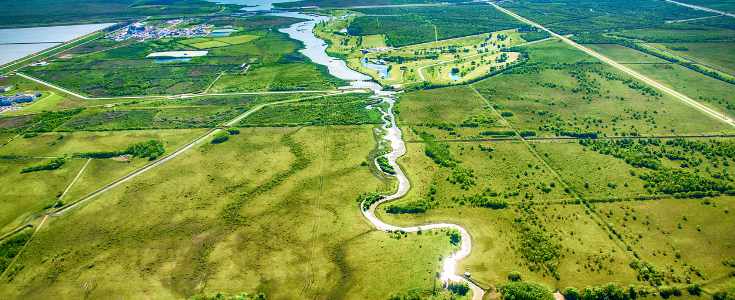The development of any communication product or project should include some combination of the steps listed in this article. We interviewed professionals in the field regarding a project they helped lead as a way of introducing the tasks and skills involved in creating business communication products. This case study explores a strategic communication project for a non-profit conservation collective.
Strategic communication concerns an organization’s capacity to effectively engage in purposeful communication through overall strategy rather than individual tactics (e.g. advertising, marketing, and public relations). During this project, the communication specialist we interviewed was involved with: collaborative project planning and evaluation, content creation, event management, and marketing and public relations.
Background
Each year, a nonprofit conservation collective in the Rocky Mountains takes on a community education initiative relating to different aspects of land use issues for the communities that lie within the surrounding watershed. An educated public helps the different stakeholder organizations make decisions, set future goals, and meet with local, state, and federal government representatives to make recommendations for regulations and laws that impact the communities.
Identify Goals, Audience, and Scope
This year, the initiative focused on floodplain education for the 2,000 residents and various stakeholders in the 160 mile watershed extending over 160,000 acres. The Communications Manager gathered a team of people from stakeholder organizations to discuss the primary messages they wanted their audience to walk away with; how to reach a critical mass of people in the widely spread communities with a population density of 0.5 people per square mile; and who to invite to make the presentations.
The group decided the key goals were to ensure everyone understood how the river was changing in its course, how that would impact landowners along the river, and how the floodplain maps might change over the coming years, which would influence insurance rates for those who had structures built in the emerging new floodplains.
Three presentations were planned for the upper, middle, and lower river section communities in local grange buildings. Finally, the group decided to invite a fluvial geomorphologist and a floodplain insurance representative from FEMA, both familiar with this specific area, to address the group and answer their questions and concerns.
Planning and Marketing
The Communications Manager contacted the managers of the three granges to schedule the presentations and arrange for refreshments, room set up, and availability of presentation equipment (e.g. screens and projectors).
In addition, they created a series of marketing products (such as event flyers) to put up at common distribution centers around the community (e.g. post offices, general stores, restaurants, and churches) and advertisements in the local and regional newspapers. The information was posted on the organization’s website and press release articles were sent to the local and regional newspapers to alert the community. Information was also sent out to organization mailing lists, including those of other affiliated organizations in the region.
Using a speakers list from the organization, the Communications Manager contacted the preferred fluvial geomorphologist and floodplain insurance representative. If these people had not been available, they would have contacted the backup individuals in their respective fields.
Develop Content
Using the most recent LiDAR (Light Detection and Ranging) maps available, the fluvial geomorphologist worked with the Communications Manager and representative from the state department of natural resources and conservation to create maps, handouts, posters, and a PowerPoint presentation. The focus was on showing the shifts in the river bed over the decades and their best effort estimate how the river would change in the next few years. Discussion points focused around how this might impact the agricultural and recreation communities.
The floodplain insurance representative used the most recent FEMA floodplain maps to develop their presentation. Their information complemented the information presented on the changing course of the river, and their handouts focused on anticipated changes to rates and the most relevant flood hazard products available from FEMA.
The Communications Manager also prepared an easel pad for the discussion section to answer questions and receive input from the community. This information was used to create additional products such as blog posts, charts, and articles which would be posted on the website and in local newspapers. These were also used in future, related presentations.
Evaluation of Product Effectiveness
At the end of each presentation, questionnaires were handed out to the audience members asking for feedback on the information and effectiveness of the presentation. Those questionnaires were tabulated, discussed at the next meeting of the conservation collaborative, and made available on their website.
Staff members also met with the two specialists at a later time to discuss their experience, what they felt was effective and what they saw was confusing to the audience. The organization used this information to create blog posts on their website to enhance the community’s understanding of the issue.
Conclusion
The annual education initiative has been a successful venture in the overall strategic communication plan for the organization over the past 15 years. Since the community is widely spread and low density, these meetings are valuable for the public as well as the organizers, to ensure that all voices are heard and taken into consideration.
In rural communities, there are conflicting needs arising around rivers and watersheds, including agricultural crops and livestock; recreation, fishing, and tourism; and conservation efforts for endangered and threatened species. A strategic communication plan ensures that information and opinions are shared and have the opportunity to influence long term policies and regulations that keep the river, watershed, and community healthy and flourishing.
Additional Business Communication Case Studies:

Crisis Communication for a Public Employee Retirement System
This case study explores the creation of a crisis communication plan and how it was used to handle a delicate situation regarding changes to an employee retirement fund. It involves strategic use of public relations, content creation, teamwork, and more.

Human Resources Communication and an Integrity Pledge
This case study examines a company HR strategy that created deep divisions throughout the organization and was ultimately unsuccessful. It deals with the creation and implementation of an Integrity Pledge meant to address issues plaguing a small business.


